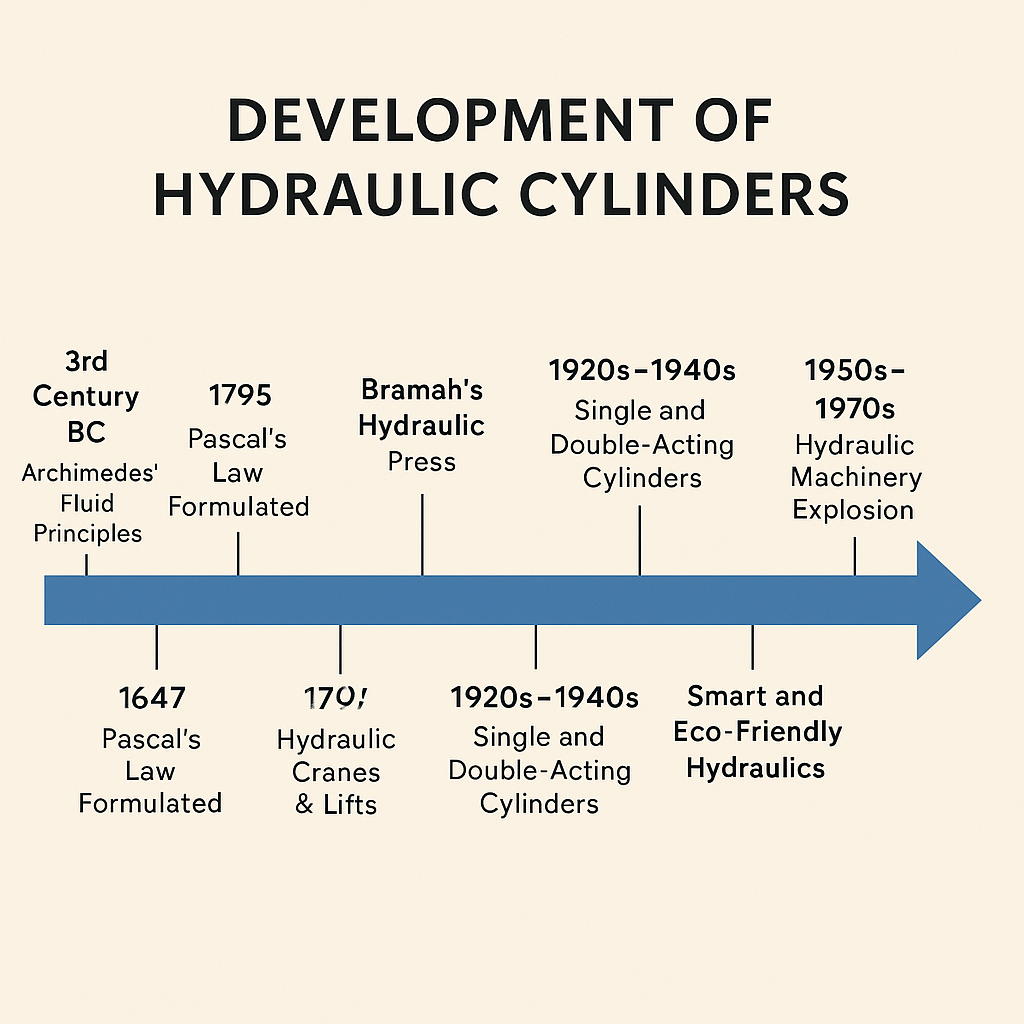The Evolution of Hydraulic Cylinders: A Historical Perspective
Hydraulic cylinders are the backbone of modern mechanical power transmission and automation. They convert fluid power into linear mechanical force and motion, powering everything from construction equipment and manufacturing machinery to elevators and aircraft. But how did we arrive at the sophisticated hydraulic systems we rely on today? Let’s take a journey through the history and evolution of hydraulic cylinders.
Origins of Hydraulic Principles – Ancient Times
The roots of hydraulic power trace back to Ancient Greece.
- 3rd century BC – Archimedes’ Principle: Archimedes of Syracuse formulated the basic laws of fluid mechanics. While not directly applied to hydraulics at the time, his discoveries laid the groundwork.
- Ancient Rome: Engineers built aqueducts and early forms of water pumps, demonstrating primitive but effective uses of water pressure.
17th Century – Pascal’s Law and the Birth of Modern Hydraulics
- 1647 – Blaise Pascal, a French mathematician and physicist, discovered that pressure applied to a confined fluid is transmitted equally in all directions.
- Pascal's Law became the theoretical foundation for modern hydraulics.
This principle sparked inventions like the hydraulic press, created by Joseph Bramah in 1795. Bramah’s press was the earliest machine to use hydraulic power for mechanical work — an ancestor of today's hydraulic cylinders.
19th Century – Industrial Revolution and Cylinder Prototypes
During the 1800s, the Industrial Revolution spurred the invention of machines that required high force in compact spaces:
- Hydraulic cranes, invented by William Armstrong in the mid-1800s, utilized cylinders to lift loads at British docks.
- Hydraulic elevators and lifting platforms appeared in mines and factories.
- These early cylinders were large, slow, and difficult to maintain but paved the way for refinement.
20th Century – The Rise of Industrial Hydraulics
With the onset of World Wars I and II, industries needed compact, mobile, and powerful equipment:
Key Developments:
- 1920s–1930s: Tractor and crane manufacturers started implementing single-acting hydraulic cylinders.
- 1940s: Double-acting hydraulic cylinders became standard, offering controlled extension and retraction.
- 1950s: The rise of hydraulic excavators, bulldozers, and forklifts drove massive adoption.
- Standardization: ISO and NFPA began establishing cylinder dimensional standards and testing norms.
Hydraulic cylinders diversified in design:
- Telescopic cylinders: Multi-stage cylinders used in dump trucks and lifts.
- Tie-rod cylinders: Modular, service-friendly cylinders for industrial automation.
- Welded-body cylinders: Compact and rugged designs for mobile equipment.

21st Century – Smart Hydraulics and Advanced Materials
As automation and precision increase, hydraulic cylinders have evolved beyond brute strength:
Major Trends:
- Sensor Integration: Position sensors and load feedback systems enable real-time control.
- Electro-hydraulic systems: Combining electronic valves and controllers for smart motion.
- Composite materials: Cylinders now use lighter and corrosion-resistant materials for extreme environments.
- Sustainable hydraulics: Bio-oils, leak-proof seals, and energy-efficient designs support green engineering.
Timeline of Hydraulic Cylinder Development
| Time Period | Key Milestones |
|---|
| 3rd Century BC | Archimedes' Fluid Principles |
| 1647 | Pascal's Law formulated |
| 1795 | Joseph Bramah invents the hydraulic press |
| Mid-1800s | Hydraulic cranes and lifts developed |
| Early 1900s | Adoption in mining and agriculture |
| 1920s–1940s | Industrial use of single and double-acting cylinders |
| 1950s–1970s | Explosion of hydraulic machinery |
| 1980s–1990s | Standardization and miniaturization |
| 2000s–Present | Smart, sensorized, and eco-friendly hydraulics
|
Future of Hydraulic Cylinders
- Integration with AI & IoT: Predictive maintenance and smart diagnostics.
- Hybrid systems: Merging hydraulics with electric actuators for hybrid power solutions.
- Compact energy storage: Better accumulator and valve integration for efficiency.
Conclusion
From water-powered inventions in ancient times to AI-integrated smart systems, hydraulic cylinders have undergone centuries of transformation. Understanding their history not only enriches our knowledge but also inspires future innovations in automation and mechanical design.
